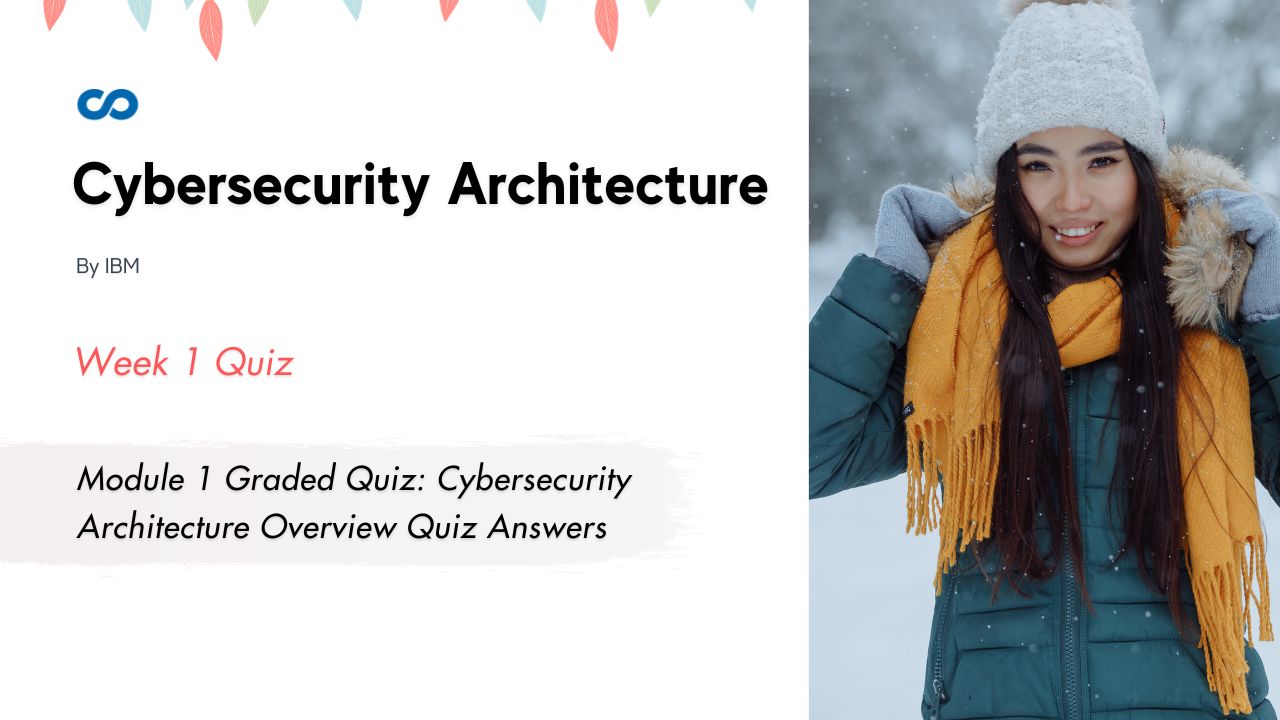Module 1 Graded Quiz: Cybersecurity Architecture Overview Quiz Answers
In this article i am gone to share Coursera Course: Cybersecurity Architecture by IBM | Week 1 | Module 1 Graded Quiz: Cybersecurity Architecture Overview Quiz Answers with you.
Enrol Link: Cybersecurity Architecture
Module 1 Graded Quiz: Cybersecurity Architecture Overview Quiz Answers
Question 1)
What is the main issue with creating overly complex security measures?
- They are too difficult to implement
- They are more expensive to maintain
- They are more easily hacked by bad actors
- They can complicate the process for good users, leading to subversion
Question 2)
What is security by obscurity?
- When the security system is hidden from view
- When the security system is reliant on secret knowledge
- When the security system is only understood by the creators
- When the security system is intentionally complex
Question 3)
How does RBAC enforce the Principle of Least Privilege?
- BAC delegates administrative work to all users.
- BAC assigns each user individual permissions for all tasks.
- RBAC categorizes users into roles and assigns permissions based on their roles.
- RBAC allows all users to access all data to ensure equal opportunities.
Question 4)
How does Privileged Access Management (PAM) contribute to upholding the Principle of Least Privilege?
- PAM provides all users with privileged access to all resources.
- PAM identifies, secures, and monitors privileged accounts, granting access only after verifying identity and access rights.
- PAM randomizes and updates credentials for all user accounts.
- PAM identifies privileged accounts and provides open access to these accounts.
Question 5)
Which of the following threatens the availability principle in the CIA triad, and what can be done to ensure it?
- Hardware failure: Implementing fail-safe mechanisms, regular backups, and disaster recovery plans
- Data tampering: applying controls and checksums
- Phishing attacks: implementing authentication and authorization
- Malware infections: Implementing encryption
Question 6)
What is a Denial of Service (DoS) attack?
- A cyber attack where the attacker gains control of the victim’s system.
- A cyber attack where the attacker steals the victim’s data.
- A cyber attack where the attacker floods the victim with an overwhelming amount of data.
- A cyber attack where the attacker changes the victim’s data.
Question 7)
What is a Distributed Denial of Service (DDoS) attack?
- A cyber attack where multiple attackers collaborate.
- A cyber attack where the victim’s system is flooded from multiple directions.
- A cyber attack where multiple systems are attacked simultaneously.
- A cyber attack where the attacker uses multiple devices to flood the victim’s system.
Question 8)
What is a SYN flood attack?
- An attack where the attacker sends a single SYN message and then sends an ACK message, causing the victim’s resources to be depleted.
- An attack where the attacker sends a single SYN message and then goes silent, causing the victim’s resources to be depleted.
- An attack where the attacker sends multiple SYN messages and then sends an ACK message, causing the victim’s resources to be depleted.
- An attack where the attacker sends multiple SYN messages and then goes silent, causing the victim’s resources to be depleted.
Question 9)
What is a botnet in the context of a Distributed Denial of Service attack?
- A server that the attacker uses to control a network of compromised computers.
- A type of software used by the victim to defend against a cyber attack.
- A type of software used by the attacker to carry out a cyber attack.
- A network of bots is used to carry out a cyber attack.
Question 10)
What are Indicators of Compromise (IoCs) in the context of cybersecurity?
- They are red flags that may point toward a potential or ongoing cyber-attack
- They are tools used by cybercriminals to breach a system
- They are the signs that a system has been compromised
- They are software solutions to prevent cyber-attacks


Hello, you have errors:
Question 2: What is security by obscurity? When the security system is hidden from view
Question 7: What is a Distributed Denial of Service (DDoS) attack? A cyber attack where the victim’s system is flooded from multiple directions.
Sorry correct ansfer is:
Question 2: What is security by obscurity? When the security system is intentionally complex
Question 7: What is a Distributed Denial of Service (DDoS) attack? A cyber attack where the attacker uses multiple devices to flood the victim’s system
For question 2 and 7 mutliple ansfers could be correct.